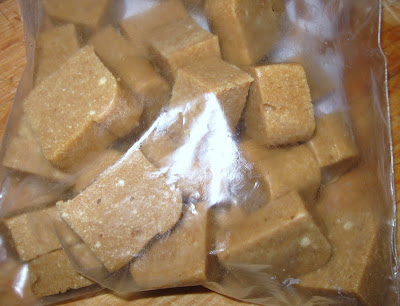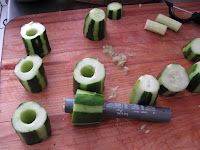This is a recipe from the cookbook Sephardic Flavors by Joyce Goldstein. It comes from the Jewish community that used to be in Cochin in south India. Now they're nearly all in Israel or New York City.
While poking through the other cookbooks my sister brought to Passover I found a surprisingly similar (if rather simpler) recipe for a beet soup with meat dumplings from Iraq called Kukkah Adom. A quick search online turns up that at least one family of the Cochin community emigrated from Iraq so this must come from that tradition.
Ingredients:
1 Tablespoon vegetable oil
1/2 onion, finely chopped
6 garlic cloves
1 carrot, diced [or two of the small CSA ones]
1 zucchini, diced [the pieces of zucchini I froze defrosted a little mushy, but otherwise intact]
1/2 celery stick, diced
4-5 cardamom pods [I seem to be out of whole cardamom so I used the powder]
1/2 teaspoon curry powder
4 vacuum-packed beet root, finely diced and juice reserved
[I've never seen a vacuum-packed beet so I have no idea how big they are. I used the full 1 1/2 pounds of CSA beets which, in retrospect, was way too much. I presume the packed beets are pre-cooked, given how they're used in this recipe, so I simmered my raw beets for 20 minutes. The picture in the cookbook had rather large pieces of beet so I went with that. If you go for the fine dice, 10 minutes will probably do. Also, I substituted 1 cup of the boiling water for the packed beet juices.]
4 cups vegetable stock
[or 2 cups beet boiling water and 2 cups chicken stock]
14 oz can chopped tomatoes
3-4 Tablespoons chopped cilantro
2 bay leaves
1 Tablespoon sugar
salt and pepper
1-2 Tablespoons white wine vinegar, to serve
for kubbeh:
2 large pinches of saffron threads
1 Tablespoon hot water
1 Tablespoon vegetable oil
1 large onion, chopped
9 oz lean minced or ground lamb
1 teaspoon vinegar
1/2 bunch fresh mint, chopped
1 cup plain flour (semolina better)
1-3 pinches salt
1/2 - 1 teaspoon turmeric
4-8 Tablespoons cold water
for ginger and cilantro paste:
4 garlic cloves, chopped
1-1 1/2 Tablespoons chopped fresh ginger
1/2 - 4 fresh mild chillies
1/2 large bunch fresh cilantro [stems included since you're going to puree everything]
2 Tablespoons white wine vinegar
salt
extra virgin olive oil

1. To make paste, put garlic, ginger and chillies in food processor and process. Add rest, process to puree. Start with a little olive oil and add more with processing until you get a nice smooth texture. Set aside.
2. To make kubbeh filling,

place saffron in hot water and leave to infuse. Heat oil in pan and fry onion until soft. Put onion and and saffron water in food processor. Blend. Add lamb, season and blend. Add vinegar and mint. Chill.
3. To make

kubbeh dough, mix flour, salt and turmeric. Add water until it forms a slightly sticky but still workable dough. Let rest 20 minutes Knead for 5 minutes, wrap in plastic and let stand 30 minutes.
4. Divide

dough into 10 - 15 pieces. Roll each into ball then roll into thin rounds. Place a spoonful of filling in each, dampen the edges, fold over or bundle up to seal. [I started by bundling up, but as I kept going along, I found myself doing more of an envelope fold and making flat square packets.] Set aside on a floured surface. [I made 12 pieces and found I had a third of the filling leftover. I'm not sure what went wrong there. Maybe my onion was too big? I made a dozen meatballs with the extra.]

5. To make soup, heat oil in pan, add onion and fry for 10 minutes until soft but not brown. Add half the garlic, the carrot, zucchini, celery, cardamom and curry. Cook 2-3 minutes.
6. Add three quarters of the diced beetroot, the stock, tomatoes, cilantro, bay leaves and sugar. Bring to boil, reduce heat and simmer for 20 minutes.
7. Add remaining beetroot, juice and garlic. Season to taste and set aside.
8. To serve, reheat soup and poach dumplings in salted water for 4 minutes. For each bowl, add a dash of vinegar, two or three dumplings [or a dumplings and three meatballs] and a small spoonful of the paste.

OK, this is a strange combination of flavors and they're not immediately gelling into a whole.
The broth is sweet from all that beet water, but not cloying. There's a lot of savory and acid in there too. And heat floating in from the cilantro paste. You can taste the beets and tomatoes in it, both mellowed. The herbs and spices do make it fragrant so the name is accurate enough.
The twenty minutes of cooking wasn't enough to cook the character out of the vegetables. All of them, even the canned tomatoes, keep their individual flavors and textures. Well actually, the beets that cooked for the twenty minutes taste just like the broth now so putting some more in at the end makes sense.
I've tried different combinations of the ingredients and I've decided I like everything but the mint. Maybe if there was just a lot less of it. Mint's supposed to go with lamb and beets, but it's just jumping to the fore and clashing with everything. Or at least with the tomatoes. That definitely doesn't work at all. If you get a piece of kubbeh without much mint, it's not bad at all. It's actually not far off from Ashkenazi kreplach so maybe heavy meat dumplings are a universal of Jewish cooking. The soup itself, when you get used to it, is not a bad chunky vegetable soup with some interestingly unusual flavors, particularly with the cilantro paste added. Not something I'd seek out, to tell the truth, but if you're a vegetable soup fan, worth a try. Maybe it'll be better after a night in the refrigerator for the flavors to meld.
OK, it's tomorrow and I'm trying a bowl without the kubbeh. Just plain, without the cilantro paste, it's extra-sweet vegetable soup. No big deal. With the paste it's a lot more interesting with an odd, but not bad combination of flavors. Oh, I forgot to add the vinegar. ... Now that makes more sense. The tart balances out the sweetness into a more unified whole. It's actually good now.
Hold on again, I'm going to boil up a kubbeh. ... I'm still not sold on the mint, but the acid tones it down a bit so it kind of works. I'm still tempted to open up the kubbeh and extract the mint with tweezers, though.
I strongly considered switching out the mint for something I liked more, but I wanted to make such an unusual recipe as written. But having done that, I have no idea if it tastes anything close to what it's supposed to. And how many people on the planet could answer that? A few thousand? Maybe I should just please myself.

















































